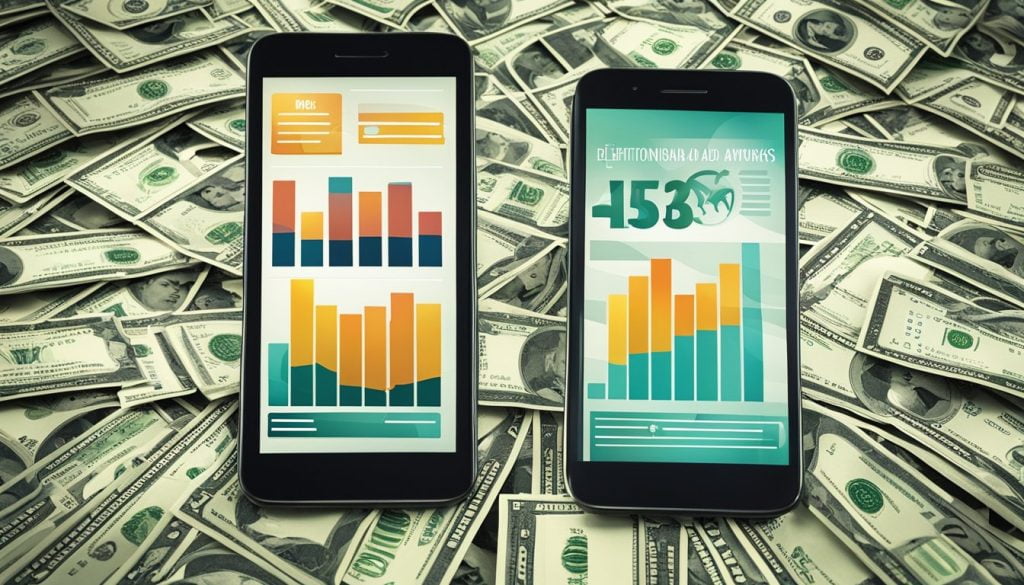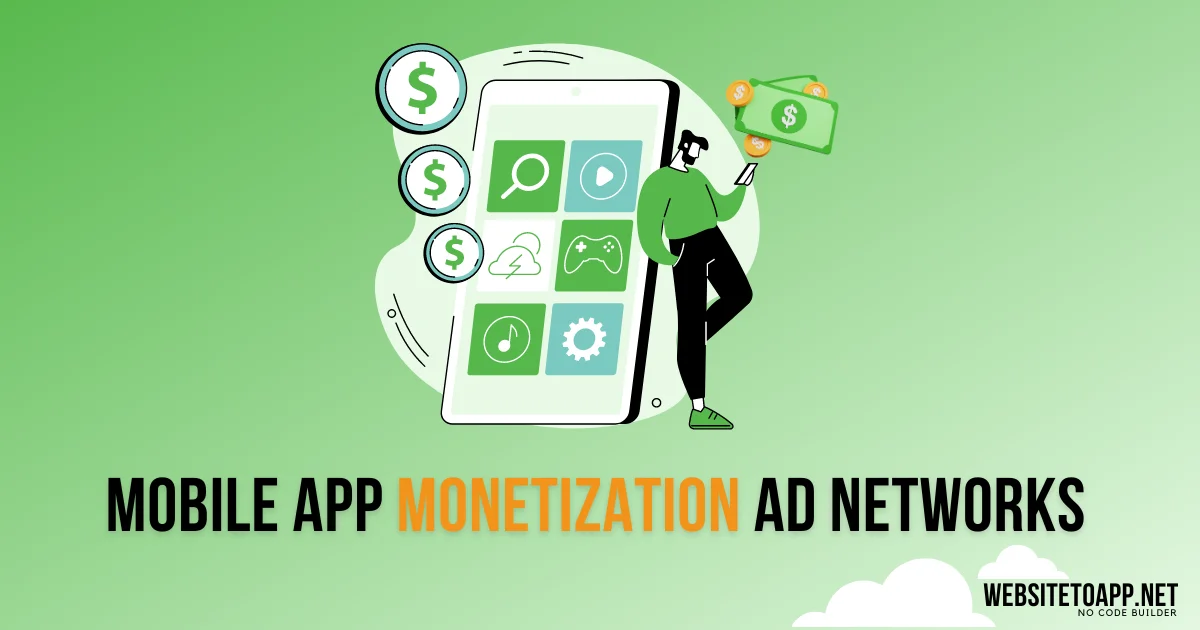Mobile app monetization is a crucial aspect of app development, and one of the most effective ways to generate revenue from apps is through advertising. However, choosing the right ad network for mobile app monetization can be challenging, given the numerous options available. To help app developers and publishers make informed decisions, this article highlights some of the best ad networks for mobile app monetization.

One of the most popular ad networks for mobile app monetization is AdMob, which is owned by Google. AdMob offers a range of ad formats, including banner, interstitial, and native ads, and supports various ad mediation networks. AdMob also provides detailed analytics and reporting tools to help app developers and publishers track their ad performance and optimize their revenue.
Another top ad network for mobile app monetization is Facebook Audience Network. This ad network allows app developers and publishers to monetize their apps by displaying targeted ads to Facebook users. Facebook Audience Network supports various ad formats, including banner, interstitial, and native ads, and provides robust targeting and optimization tools to maximize revenue. Additionally, the network offers detailed reporting and analytics to help app developers and publishers track their ad performance.
Overview of Mobile Ad Networks
Mobile ad networks are platforms that connect mobile app publishers with advertisers, allowing them to monetize their apps and generate revenue through mobile advertising. Ad networks provide a variety of ad formats including display ads, native ads, video ads, and more. These ads can be targeted to specific audiences based on demographics, location, interests, and other factors.
Mobile ad networks have become increasingly important in recent years as mobile app usage continues to grow. According to recent data, mobile apps account for over 90% of internet time on smartphones. As a result, mobile app publishers are turning to ad networks to monetize their apps and generate revenue.
There are many mobile ad networks available, each with its own strengths and weaknesses. Some of the most popular mobile ad networks include:
- Google AdMob
- Facebook Audience Network
- Unity Ads
- AppLovin
- IronSource
Each of these ad networks offers unique features and benefits, and choosing the right one for your app can be a challenge. Factors to consider include ad format, targeting options, revenue share, and more.
In summary, mobile ad networks are an essential tool for mobile app publishers looking to monetize their apps and generate revenue through advertising. With so many options available, it’s important to carefully evaluate each ad network to find the one that best meets your needs.
Criteria for Choosing an Ad Network

When it comes to choosing the best ad network for mobile app monetization, there are several factors to consider. Here are some of the most important criteria to keep in mind:
Revenue Models
Different ad networks offer different revenue models, such as cost-per-click (CPC), cost-per-impression (CPM), cost-per-install (CPI), and revenue sharing. It’s important to choose an ad network that offers a revenue model that aligns with your app’s goals and target audience. For example, if your app has a high engagement rate, a revenue sharing model may be more profitable than a CPM model.
Ad Formats Supported
The ad formats supported by an ad network can impact the user experience of your app. Choose an ad network that supports ad formats that are non-intrusive and appropriate for your app’s content. Some common ad formats include banner ads, interstitial ads, native ads, and rewarded video ads. Consider which formats will provide the best user experience while also generating revenue.
Ease of Integration
The ease of integration is another important factor to consider when choosing an ad network. Look for an ad network that offers easy-to-use SDKs and APIs that can be integrated seamlessly into your app. The integration process should be straightforward and not require extensive technical knowledge.
Reporting and Analytics
The ability to track and analyze ad performance is crucial for optimizing your app’s revenue. Look for an ad network that provides detailed reporting and analytics on ad performance, including metrics such as click-through rates, impressions, and revenue generated. The ad network should also provide real-time reporting to help you make informed decisions about ad placement and optimization.
Developer Support
Finally, choose an ad network that offers reliable developer support. The ad network should provide responsive and helpful customer support to help you troubleshoot any issues that arise. Additionally, the ad network should offer resources such as documentation, tutorials, and forums to help you maximize your app’s revenue potential.
Top Ad Networks for Mobile Apps
Mobile app monetization is a crucial aspect of app development. One of the most effective ways to monetize a mobile app is through mobile ad networks. Here are some of the top ad networks for mobile apps:
Google AdMob
Google AdMob is one of the most popular mobile ad networks, with more than 1 million apps using it for monetization. It offers a variety of ad formats, including banner ads, interstitial ads, and native ads. AdMob also provides detailed analytics and reporting tools, allowing developers to optimize their ad performance.
Facebook Audience Network
Facebook Audience Network is another popular mobile ad network, with over 1 billion daily active users. It provides a range of ad formats, including banner ads, interstitial ads, and native ads. Audience Network also offers advanced targeting options, allowing developers to reach specific audiences based on demographics, interests, and behaviors.
Unity Ads
Unity Ads is a mobile ad network specifically designed for mobile games. It offers a variety of ad formats, including rewarded video ads, which allow users to earn in-game rewards by watching ads. Unity Ads also provides detailed analytics and reporting tools, allowing developers to optimize their ad performance.
AppLovin
AppLovin is a mobile ad network that provides a range of ad formats, including interstitial ads, native ads, and rewarded video ads. It offers advanced targeting options, allowing developers to reach specific audiences based on demographics, interests, and behaviors. AppLovin also provides detailed analytics and reporting tools, allowing developers to optimize their ad performance.
IronSource
IronSource is a mobile ad network that provides a range of ad formats, including banner ads, interstitial ads, and rewarded video ads. It offers advanced targeting options, allowing developers to reach specific audiences based on demographics, interests, and behaviors. IronSource also provides detailed analytics and reporting tools, allowing developers to optimize their ad performance.
In conclusion, mobile ad networks are an effective way to monetize mobile apps. Developers should choose an ad network that best fits their app and audience. The above-mentioned ad networks are some of the top choices for mobile app monetization.
Maximizing Revenue with Ad Mediation
Understanding Ad Mediation
Ad mediation is a process of optimizing ad revenue by connecting mobile app developers with multiple ad networks. This process allows developers to display ads from different networks in their apps, which maximizes their revenue potential. Ad mediation platforms act as a mediator between app developers and ad networks, and they use algorithms to determine which ad network will provide the highest revenue for each ad impression.
Benefits of Using Mediation Platforms
There are several benefits of using ad mediation platforms for mobile app monetization. First, they provide access to a large pool of ad networks, which increases the likelihood of finding the best ad for each impression. Second, they use advanced algorithms to optimize revenue by choosing the best ad network for each impression. Third, they simplify the process of managing multiple ad networks by providing a single dashboard for tracking performance and revenue.
In addition, ad mediation platforms provide developers with tools to manage ad frequency, ad formats, and ad targeting. They also offer real-time reporting and analytics, which allows developers to monitor their revenue and make informed decisions about their ad strategy. Overall, ad mediation platforms are a valuable tool for maximizing revenue and streamlining the process of mobile app monetization.
Programmatic Advertising and Real-Time Bidding

Programmatic advertising is an automated process of buying and selling digital advertising space. It helps advertisers to reach their target audience more effectively by using data and algorithms to purchase ad inventory. Programmatic advertising is becoming increasingly popular in mobile app monetization due to its efficiency and the ability to reach a larger audience.
Real-time bidding (RTB) is a type of programmatic advertising that allows advertisers to bid on ad inventory in real-time. This means that advertisers can bid on ad space the moment it becomes available, making it a more efficient and cost-effective way to purchase ad space.
RTB is popular in mobile app monetization because it allows advertisers to target specific audiences in real-time, increasing the chances of conversions. It also allows advertisers to optimize their campaigns by adjusting bids and targeting based on real-time data.
The table below shows some of the top programmatic advertising and real-time bidding platforms for mobile app monetization:
| Platform | Description |
|---|---|
| PubMatic | An SSP and ad exchange that supports private marketplaces programmatic deals. Offers a wide range of programmatic ad formats: banners, in-app, interstitial, native, rewarded video, rich media, and video. Offers detailed real-time analytics. |
| Google Ad Manager | A programmatic ad platform that allows publishers to manage and sell their ad inventory. Offers a range of programmatic ad formats: banners, in-app, interstitial, native, rewarded video, rich media, and video. Offers detailed real-time analytics. |
| Rubicon Project | An SSP and ad exchange that supports private marketplaces programmatic deals. Offers a wide range of programmatic ad formats: banners, in-app, interstitial, native, rewarded video, rich media, and video. Offers detailed real-time analytics. |
| OpenX | An SSP and ad exchange that supports private marketplaces programmatic deals. Offers a wide range of programmatic ad formats: banners, in-app, interstitial, native, rewarded video, rich media, and video. Offers detailed real-time analytics. |
Overall, programmatic advertising and real-time bidding are becoming increasingly popular in mobile app monetization due to their efficiency and ability to reach a larger audience. Advertisers can benefit from using these platforms to optimize their campaigns and reach their target audience more effectively.
Impact of User Experience on Monetization

When it comes to mobile app monetization, user experience plays a critical role in determining the success or failure of the app. The quality of user experience can have a direct impact on the app’s monetization potential.
One study showed that low-quality ads, too many ads, or disrupted ads that create a poor user experience can result in churn rates that are 20 times higher than average. It is essential to ensure that the ads are not disruptive and do not negatively impact the user experience.
Developers need to strike a balance between monetization and user experience. They can do this by using non-intrusive ad formats such as interstitial ads or rewarded video ads that offer value to the user while generating revenue for the app.
It is also important to remember that the user experience is not just about the ads. The app’s overall design, functionality, and performance can also impact the user’s perception of the app. Therefore, developers should focus on creating a seamless user experience that enhances the app’s value proposition and keeps users engaged.
In conclusion, the impact of user experience on mobile app monetization cannot be overstated. Developers need to prioritize user experience while implementing monetization strategies to ensure that they do not negatively impact the app’s retention and revenue potential.
Privacy and Data Protection Considerations

When it comes to mobile app monetization, privacy and data protection are critical considerations. App developers and publishers need to ensure that they comply with data privacy regulations and protect users’ data from unauthorized access and misuse.
To achieve this, it is important to choose ad networks that prioritize data privacy and protection. Some ad networks have implemented measures to ensure that user data is collected and used in a responsible and transparent manner. For example, they may provide users with clear information about the data that is collected and how it is used, as well as the ability to opt-out of data collection.
In addition, some ad networks have implemented data protection measures such as encryption and secure data storage to prevent unauthorized access. It is important to choose ad networks that have implemented such measures to protect users’ data.
It is also important to note that app developers and publishers have a responsibility to ensure that their apps comply with data privacy regulations. This includes obtaining user consent for data collection and ensuring that user data is stored securely.
Overall, choosing ad networks that prioritize data privacy and protection is crucial for mobile app monetization. By doing so, app developers and publishers can ensure that they comply with data privacy regulations and protect users’ data from unauthorized access and misuse.
Emerging Trends in Mobile App Monetization

As the mobile app market continues to grow, developers are constantly looking for new ways to monetize their apps. Here are some emerging trends in mobile app monetization:
Out-of-App Monetization
One trend gaining traction is out-of-app monetization, particularly through web stores. This trend is especially prevalent in regions with limited credit card access, such as Southeast Asia, where it accounts for 21% of global mobile game revenue. In certain markets, like China, third-party distribution contributes to 53% of app revenue.
In-App Purchases
In-app purchases remain a popular way to monetize mobile apps. According to a recent report, fintech in-app revenue is booming, up 90% and appears promising for the future. One factor contributing to this growth is the ongoing shift towards digital financial services, which is expected to persist.
Mobile Ad Networks
Mobile ad networks have become a major inventory for ads to be displayed, replacing the traditional mobile web. Ad networks are a handy tool of the ad tech field. Google AdMob is the most popular mobile advertising network, with millions of app developers using it. You must provide advertising space in your application to have access to AdMob.
New Payment Methods
New payment methods are also emerging, such as cryptocurrency and micropayments, which allow users to make small purchases within an app. These methods are gaining popularity, particularly in regions where traditional payment methods are less common.
Overall, developers need to stay up-to-date with the latest trends in mobile app monetization to ensure they are maximizing their revenue potential.
Case Studies: Successful Monetization Strategies

To better understand how to successfully monetize a mobile app, it’s important to look at some case studies of apps that have implemented effective monetization strategies. Here are a few examples:
1. Candy Crush Saga
Candy Crush Saga is a popular mobile game that has been able to generate significant revenue through in-app purchases. The game offers players the option to purchase boosters and extra lives to help them progress through levels. By providing these optional purchases, Candy Crush Saga has been able to generate an estimated $1.5 billion in revenue.
2. Spotify
Spotify is a music streaming app that offers both free and paid subscription options. The free version of the app is supported by ads, while the paid version offers an ad-free experience and additional features such as offline playback and higher quality audio. By offering a range of subscription options, Spotify has been able to generate significant revenue and maintain a large user base.
3. Instagram
Instagram is a social media app that has implemented a variety of monetization strategies. In addition to offering advertising options for businesses, Instagram has also introduced features such as sponsored content and shoppable posts. These features allow influencers and content creators to monetize their content and provide businesses with new advertising opportunities.
By looking at these successful case studies, mobile app developers can gain valuable insights into effective monetization strategies. Whether through in-app purchases, subscription options, or advertising, there are a variety of ways to generate revenue from a mobile app.
Future of Mobile App Advertising
Mobile app advertising has come a long way since its inception and it is expected to continue evolving in the future. With the increasing number of mobile users worldwide, businesses are looking for ways to reach their target audience through mobile apps. As a result, mobile app advertising has become a major inventory for ads to be displayed in, replacing the traditional mobile web.
In the future, there will be a greater emphasis on personalized and relevant ads. Advertisers will be able to use data from user behavior and preferences to create ads that are more targeted and effective. This will lead to a higher click-through rate and better user engagement.
Another trend that is expected to continue in the future is the use of video ads. Video ads have proven to be more engaging and effective than traditional banner ads. Advertisers will be able to use interactive and immersive video ads to create a more engaging experience for users.
In addition, programmatic advertising will continue to grow in the future. Programmatic advertising allows advertisers to automate the buying and selling of ad inventory in real-time. This will lead to more efficient and effective ad campaigns.
Overall, the future of mobile app advertising looks bright. With the increasing number of mobile users and the evolution of technology, advertisers will be able to create more personalized and engaging ads that are tailored to the needs and preferences of their target audience.
